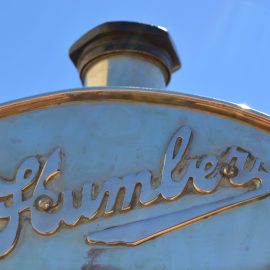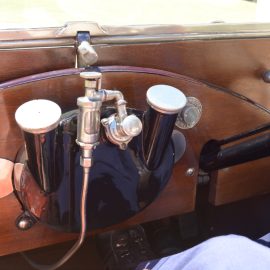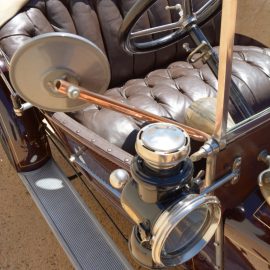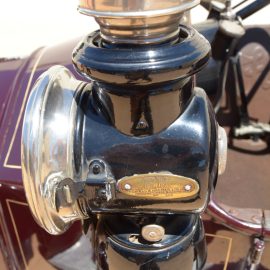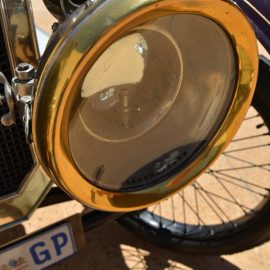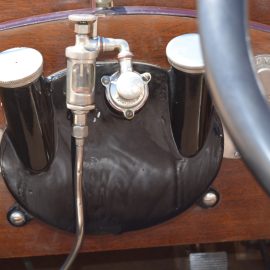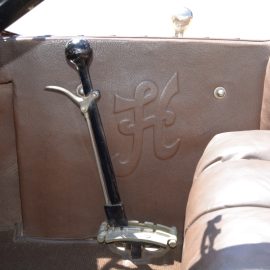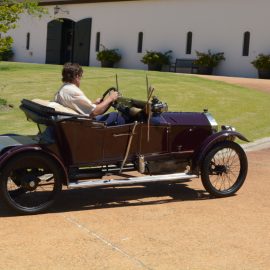
15 Dec Collection In Action: Humberette
Mike Monk describes a centenarian that bridged the gap between motorcycles and cars…
Just over a century ago one of deadliest conflicts in history, World War One, began in earnest and lasted four years with enormous loss of life – counted in millions – of both troops and civilians. But as anyone familiar with the book/movie/stage adaptation of Michael Morpurgo’s book War Horse will know, almost as many horses as humans died during the trench warfare. Armoured vehicles based on cars of the period were available in limited numbers, but battles were generally fought on foot and hooves. When the conflict broke out the automobile industry itself was trying to meet the demands of society eager to move up into the world of the horseless carriage. At the beginning of the last century motoring was virtually an activity of the wealthy, but by 1910 increasing numbers of middle class citizens eager to join the movement demanded affordability that, in turn, led to the advent of the cyclecar.
Generally speaking, a cyclecar is a simply constructed, lightweight car with a small capacity engine (usually a single-cylinder or V-twin), a variation on what are often generally referred to as light cars or, in French, voiturettes. Manufactured mainly between 1910 and the late 1920s, cyclecars bridged the gap between the motorcycle and the car and almost by definition, reliability was not necessarily a given due to the fragile engineering. In 1911 the number of cyclecar manufacturers was less than a dozen in each of the United Kingdom and France, but by 1914 there were over 100 in each country and even more in Germany, Austria and other European countries. While a reasonable number of the many vehicles that were produced by both the established and aspirant manufacturers were successful, practically all of them had a short lifespan due to the outbreak of WWI. One of the better examples is the 1914 Humberette.
The British Humber Car Company evolved from Thomas Humber’s bicycle company founded in 1868, and following repeated requests to produce a motorised vehicle – delayed while Humber sought a suitable engine – a three-wheeled car was produced in 1898, followed by a four-wheeler in 1901. From factories in Beeston, near Nottingham, and Coventry a broad model line-up was soon established, ranging from a single-cylinder 611 cc Humberette to several six-cylinder 6,0-litre models. By 1913, Humber was the second largest manufacturer of cars in the UK.
The first 5hp Humberette appeared in 1903 and a year later its engine was increased to 762 cc. This car was succeeded in 1912 by a much more substantial model fitted with a 998 cc 8hp V-twin air-cooled engine with drip-feed lubrication, a leather-lined cone clutch, a three-speed plus reverse gearbox and shaft drive to a differential rear axle. However, despite being tagged a cyclecar, the 7 cwt (784 kg) Humberette marginally exceeded requirements for the Large Class of a newly instigated two-level classification of cyclecars that specified a maximum weight of 350 kg, a maximum engine capacity of 1 100 cc and a minimum tyre section of 60 mm (2,4 inches). Respective figures for the Small Class were 150/300 kg min/max, 750 cc and 55 mm (2,2 in.). All cyclecars were to have clutches and change-speed gears.
Despite its minimalism, the Humberette’s two-seat body with centrally-hinged bonnet, lengthy scuttle and upright windscreen made it look relatively substantial. Its specification included such niceties as rack-and-pinion steering, a foot-operated band brake operating on the transmission shaft, and two external-contracting drum brakes on the rear wheel hubs activated by a handbrake. Front suspension was by a transverse semi-elliptic leaf spring with quarter-elliptics doing duty at the rear. Drive from the diff was via spring-loaded torque rods, and for topping up the diff, a hatch in the flat boot could be raised giving access to the brass filler. Wire-spoked wheels were fitted with 2,5-inch beaded-edge tyres. The engine had high-tension magneto ignition and a Smith four-jet carburettor. Hand levers controlled the throttle and ignition.
Newspaper advertisements from 1913 promoted the Humberette as `The Perfect Car in Miniature’ and in a paper entitled The Car and British Society published by Manchester University Press in 1998, it was stated as being “… the most popular of cyclecars at that time”. In 1914 the car received minor upgrades, and a water-cooled version with a front radiator was added, as fitted to the Franschhoek Motor Museum’s example – thought to be one of only 50 left in the world.
For a car that has just passed its 107th birthday, the Humberette looks remarkably healthy, the sun reflecting off its maroon paintwork highlighted in places by hand-painted pinstripes. The lamps are works of art – headlights are ornate Lucas King of the Road items – and with all the steering, brake and suspension components visible through and under the bodywork, motorised transport does not get more honest than this.
With hood stowed, a veteran drive begins with opening the fuel line, setting the appropriate levers and turning the starting handle. The V-twin immediately bursts into life and settles to an even beat, the exhaust surprisingly crackly, spitting with all intent – all six kilowatts worth. But it surprises with the sprightly manner in which it pulls away and settles down, easily moving through the gears into a slow but steady gait to the accompaniment of that crackly exhaust. Vibration is hardly noticeable and the ride most comfortable, the 26-inch wheels shod with tyres somewhat confusingly marked 700×80 mm and 26×3 inches – do the sums…
It is a real step back in time to a period when efforts were being made to make the motor car available if not to every man, then certainly to a rapidly increasing number of the world’s population, those spared from paying the ultimate price of war. Production of the Humberette ceased in 1915 and was not revived after WWI when cyclecar popularity steadily declined, largely the result of production economies in the manufacture of more substantial and affordable light cars such as the Austin 7, Citroën 5CV and Morris Cowley. After WWII, small, economic cars were again in demand and a new set of manufacturers appeared, but the cyclecar name did not reappear as the new breed was called microcars by enthusiasts.
As a brief aside, it may be easy to overlook the cyclecar era as a passing fad but, in fact, it led to some significant developments. In 1912, the Cyclecar Club was formed that evolved into the British Automobile Racing Club (BARC), which famously exists today. The same year saw the Motor Cycle Show at Olympia become the Motor Cycle and Cycle Car Show, and on 27 November 1912, Temple Press launched The Cyclecar magazine that was later renamed The Light Car and Cyclecar and finally The Light Car and was published until the early 1950s.
Humber became part of the Rootes Group in 1931 until that company was taken over by Chrysler in 1967. The Humber name lasted until 1976 and now belongs to Peugeot after it bought Chrysler’s European operations in 1978. It is a pity that a name that played an important role in the evolution of the automobile is no more, but today the company’s Humberette cyclecar stands proud as a prime example of early progress.
FMM’s Humberette is currently on view in Hall C.




